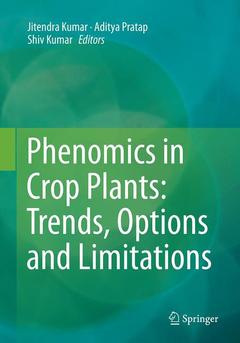Description
Phenomics in Crop Plants: Trends, Options and Limitations, Softcover reprint of the original 1st ed. 2015
Trends, Options and Limitations
Coordinators: Kumar Jitendra, Pratap Aditya, Kumar Shiv
Language: English
Subjects for Phenomics in Crop Plants: Trends, Options and Limitations:
Keywords
Crop sensing; Genomics; Insect pest; Phenotyping; X-ray imaging; Proteomics
Phenomics in Crop Plants: Trends, Options and Limitations
Publication date: 10-2016
Support: Print on demand
Publication date: 10-2016
Support: Print on demand
Phenomics in Crop Plants: Trends, Options and Limitations
Publication date: 03-2015
296 p. · 17.8x25.4 cm · Hardback
Publication date: 03-2015
296 p. · 17.8x25.4 cm · Hardback
Description
/li>Contents
/li>Biography
/li>Comment
/li>
Identification of desirable genotypes with traits of interest is discernible for making genetic improvement of crop plants. In this direction, screening of a large number of germplasm for desirable traits and transfer of identified traits into agronomic backgrounds through recombination breeding is the common breeding approach. Although visual screening is easier for qualitative traits, its use is not much effective for quantitative traits and also for those, which are difficult to score visually. Therefore, it is imperative to phenotype the germplasm accessions and breeding materials precisely using high throughput phenomics tools for challenging and complex traits under natural, controlled and harsh environmental conditions. Realizing the importance of phenotyping data towards identification and utilization of a germplasm as donors, global scientific community has exerted increased focus on advancing phenomics in crop plants leading to development of a number of techniques and methodologies for screening of agronomic, physiological, and biochemical traits. These technologies have now become much advanced and entered the era of digital science. This book provides exhaustive information on various aspects related to phenotyping of crop plants and offers a most comprehensive reference on the developments made in traditional and high throughput phenotyping of agricultural crops.
1. Plant Phenomics: An Overview.- 2. Traits for Phenotyping.- 3. High Precision Phenotyping under Controlled versus Natural Environments.- 4. Towards Digital and Image Based Phenotyping.- 5. Imaging Methods for Phenotyping of Plant Traits.- 6. Screening for Plant Features.- 7. Phenotyping Crop Plants for Drought and Heat Related Traits.- 8. Phenotyping for Root Traits.- 9. Phenotyping for Soil Problems.- 10. Phenotyping Methods of Fungal Diseases, Parasitic Nematodes and Weeds in Cool Season Food Legumes.- 11. Advances in Phenotyping of Functional Traits.- 12. Role of Fluorescence Approaches to Understand Functional Traits of Photosynthesis.- 13. Identification of Subcellular Structural and Metabolic Changes through NMR.- 14. Precision Nutrient Management and Crop Sensing.- 15. Phenotyping Nutritional and Anti-Nutritional Traits.- 16. Experimental Designs for Precision in Phenotyping.- 17. Biometrical Approaches for Analysis of Phenotypic Data of Complex Traits.- 18. Harnessing Genomics through Phenomics.- 19. High Throughput Plant Phenotyping Platforms.
Dr. Jitendra Kumar, born in 1973, is presently working as a Senior Scientist in the Division of Crop Improvement at Indian Institute of Pulses Research, Kanpur. He has an excellent research career throughout. He secured Gold Medal during masters’ programme and pursued his Ph.D. in Genetics & Plant Breeding from G. B. Pant University of Agriculture & Technology, Pantnagar, India. He was awarded CSIR-Research Associateship during 2003-2005 for postdoctoral studies at the Institute of Integrative Medicine, Jammu (India). He has more than 14 years of research experience in genetic improvement using both conventional and molecular marker-assisted breeding approaches on various crops including sunflower, medicinal and aromatic, cereal and pulse crops. He has done work on development of SSR markers, identification of QTLs for preharvest sprouting and high grain protein content and marker assisted breeding in wheat for pyramiding the preharvest sprouting tolerance and high grain protein content and leaf rust resistance and developed a number of lines. During this period, he undertook study tours of several countries including Austria, Syria, Bangladesh, Nepal, Lebanon and Canada. His research interests include conventional and molecular breeding, QTL analysis and marker assisted selection for crop improvement. He has more than 100 publications including research and review articles in reputed national and international journals, book chapters, meeting reports, popular articles, and bulletins. He has also co-edited three books including “Biology and Breeding of Food Legumes” published by CABI, Oxfordshire, “Alien Gene Transfer in Crop Plants: Innovations, Methods and Risk Assessment” and “Alien Gene Transfer in Crop Plants: Achievement and Impacts” both published by Springer, New York, USA. He has developed high-yielding varieties (IPL 316 and IPL 526) of lentil and several others are in pipeline. His current priorities include involvement ofmolecular marker technol
Well-known scientists from across the world have contributed in this book, adding to its global relevance Developments made in major food crops of the world are discussed in detail The theme of the book will address the issue of food security,relevant especially for the developing economies A number of advanced techniques and methodologies for screening of agronomic, physiological, and biochemical traits of plants are discussed exhaustively
© 2024 LAVOISIER S.A.S.




